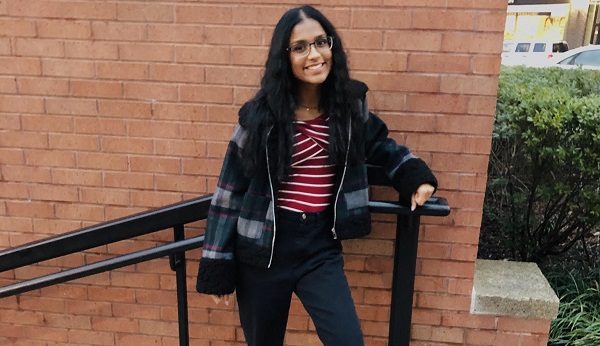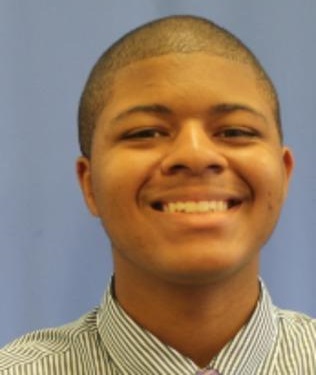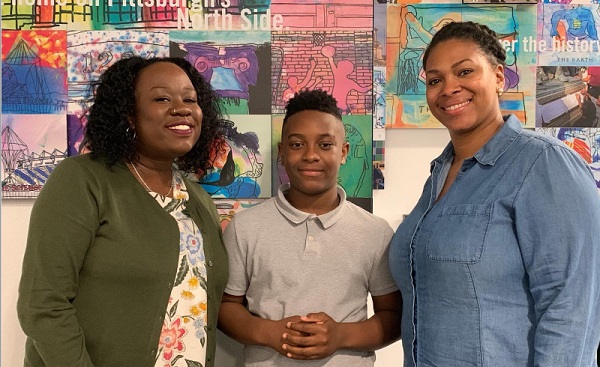
These Pittsburgh kids bring fresh perspectives on solutions to violence
Photo: Srilekha Sapram of Gateway High School
What do you think could be done to change the violence in your neighborhood?
What kind of plan would you develop to stop violence in your community?
Pittsburgh kids were asked these questions in an essay contest to address a subject very close to many of their communities.
Launched by the Pittsburgh chapter of Black Women for Positive Change (BW4PC), a national anti-violence organization, the contest invited 21 area schools and 13 afterschool community programs to participate. Entries came from kids ages 11 to 18 years old. Many of the participants shared first-hand experiences of the loss of a loved one or the fear they carry with them.
“Their perspective cuts right to the heart,” says Richard M. Carrington, Sr., executive director of Voices Against Violence and one of the contest judges. “I work daily with the repercussions of violence, the senseless loss of life and potential, and these young people are absolutely right. We aren’t doing enough to ensure they are safe and give them the promise of a brighter future.”
Understanding the youth perspective is essential to developing viable plans to address the issues. These kids may very well be the creative problem-solvers needed to identify and make the significant changes required to overcome the challenges facing many of our communities.
“It is important to seek the student voice when addressing concerns in their community,” says Diane Powell, co-chair for Black Women for Positive Change – Pittsburgh and creator of the contest. “I am incredibly pleased with the responses from the participants, touched by their stories, and impressed by their practical suggestions.”
Included here are excerpts from three of the winning essays:
Protecting the future of our society
First place: Srilekha Sapram, 17, Gateway High School
Violence. It is a single word, yet it affects people in exorbitant amounts all over the world. It can destroy one’s past and change his/her future. Preventing violence could save the future of our society by helping young people who are affected by violence in communities across America. Violence has been on the rise in America at unprecedented rates and has been shown to increase unless changes are made. I believe that the best way to stop the destructive consequences that result from violence is through education, creating new programs, limiting social media radicalization, and normalizing seeking help.
Through spreading awareness of problems caused by different types of violence (gang violence, gun violence, abuse, etc.), it will be easier to sway the young people away from participating in those activities. Advertising the dangers of drugs such as nicotine products (vapes, Juuls, etc) have been shown by studies to reduce the consumption of those products, so why has this model not been applied to other areas?
Health classes in schools are brimming with information about the dangers of drugs and diseases, but they fail to cover an important area that leads to many of their young students suffering: violence. I believe that asking school districts and other public spaces where people can receive information (such as public libraries) to educate people about the dangers of violence, how to recognize early signs of violence, and how to deal with it will save the lives of many. For example, a student who learns about the signs of abuse could recognize that his/her significant other or family display the same signs, and he/she has a chance to seek help. Without being educated, there is a possibility that the student could have never escaped the cycle of abuse. …
Creating new programs for youth is essential to stopping the negative effects of violence in our communities. An astronomical factor of one’s life is the environment that he/she grew up in. It is a well-known scientific fact that a child’s environment affects how they behave and the quality of their life. Young people who live in socially and economically disadvantaged neighborhoods stereotypically live around violence in their everyday life. Creating these programs can give kids the option to stay in a safe place, away from danger or unsavory circumstances. Designed to be educational or just entertaining, these afterschool programs create an outlet for all young people, which can remove them from unhealthy situations while encouraging them to make new friends and open up new, different experiences. …
Social media, despite its praise for spreading information and connecting societies around the world, advances negativity on to the youth in the form of social media bullying, another type of “violence.” Trapped in today’s social media, young people are targeted by people on social media, who hide behind social media’s promises of anonymity. Social media bullying becomes especially harmful when combined with bandwagoning, which can lead to a lesser addressed form of violence: suicide. …
In many communities across America, mental health issues are treated as “fake” illnesses. As social pressures continue to increase, a “new” type of violence has also increased in the form of suicidal behaviors and suicide itself. As an immigrant and therefore being familiar with immigrant communities, I have seen how my community treats mental illnesses as something to be ashamed of, and I have also seen how it drove people in my community to take drastic measures after not having any way to help handle their illness and commit suicide. Normalizing the stigma that surrounds mental illness would be crucial in preventing violence surrounding it. I believe that helping normalize mental illness by bringing awareness to its effects and creating groups where young people can come to share and discuss their troubles would help them immensely.
Imagining ‘ZEAL’ as a foundation to eliminate violence in Pittsburgh
Second place: Aidan Nichols, 15, Central Catholic High School

What we need is a central place for everyone, no matter the preference, age, or origins. I would call this organization ZEAL (Definition-“great energy or enthusiasm in pursuit of a cause or an objective.”) because its foundation is the great desire for change. …
This organization would be a place where destructive behavior would be not tolerated but will not inflict severe punishment against those who are accustomed to that type of lifestyle. The goal isn’t to give judgment and persecute individuals, but rather to reform issues in the community and bring us, as a people, closer. …
ZEAL would be interested in the incubation of its members’ passion. They would be involved with local organizations that support a broadened view of constructive and healthy ways to express, evolve, and better oneself. It can be hard to find a place in which you can call your second home or a place where you can stay and not have to worry if this is what you really want. That’s why ZEAL would provide guidance and direction for those who wish to explore certain groups and organizations; informing the public with times in which public seminars are to take place. ZEAL would be a place that takes pride in the success and development of its members.
ZEAL would teach the children to find their own path to greatness; show them that the world is changing and they are the forefront of it. They are the next president, next groundbreaking engineer, next community leader. … ZEAL would care about bullying and the mental well-being of those children because they’ve seen what that mental instability looks like. ZEAL would know that the way to reach change is if they create the change in those who would proceed them: The youth full of dreams and aspirations.
ZEAL is a dream. … But if I were to be more realistic with finding a way to achieve this dream, my first step would be introducing myself to at least one new neighbor a week. This all starts with a “hello” to someone you don’t know. You need to not only desire for change but resolve to take action for that change. The world needs to take action; it just doesn’t have a strong enough force to push it through the walls of negativity blocking it.

Community ties and youth representation can help protect kids
Honorable mention: Darryl Strong, 12, Manchester Academic Charter School
Violence has affected my life because my family has gotten hurt and killed by people that do the wrong thing and hang around the wrong people. I have restrictions on where and when I go places because of the actions of other people doing violent things. I am sometimes afraid to go outside my house and into other neighborhoods because of the violent acts of other people. Even my football practices were canceled because of a shooting that happened right next to the field we were practicing at where an innocent person from the cheerleaders got shot. She had nothing to do with the violence but was just there practicing cheers. …
I know some kids my age who do not have to go home after school and stay out really late. This allows them to get into trouble because they have too much free time with nothing to do. Children my age hang with the wrong people and do criminal things with these people. Their parents may have to work a few jobs to pay their bills allowing their children to be free during this time.
Some kids follow other kids who do violent things so they can feel that they belong somewhere. Drugs are also behind some of the violence. Drug addiction causes the sale of drugs to bring in a lot of money. … Some kids do this to help their family pay bills and buy food. Sometimes it is their family members, parents or older siblings, that might be selling the drugs putting the whole family in danger. … Having a parent who is an addict can cause a young person to turn to the streets because he feels so embarrassed and doesn’t care anymore about anything. …
If I knew anyone like this, I would try to convince them that their life is worth more than being ended by violence or going to jail. I would try to find some positive activities that would occupy our time doing the right things. I would talk with my mom or grandma, who use to be a police lieutenant, to see if there is anything that could be done to help him. If the problem was an addiction I would try to encourage them to get help getting off of the drugs. If they were selling drugs, I would try to convince them that they were selling poison that has killed people and broken up families. I would tell them that no matter how much money they made would it be worth someone’s life. …
I would start with a group of my friends and form a club that starts to bring my age group of kids together. We can go to other schools and try to get other kids to join who want to make a difference. We can organize protests when things happen that are violent. We can also have activities to bring kids in like parties, skating and sports. We would set rules that no guns or drugs are allowed at any of our activities. I would want to hear if other kids have any ideas so that everyone feels that they are a part of our group. I would ask adults like teachers, police, politicians (council members, mayors, state representatives) football and baseball players, to help support us and come in and talk with us. I would want to show kids that we are cool without carrying guns and doing drugs.